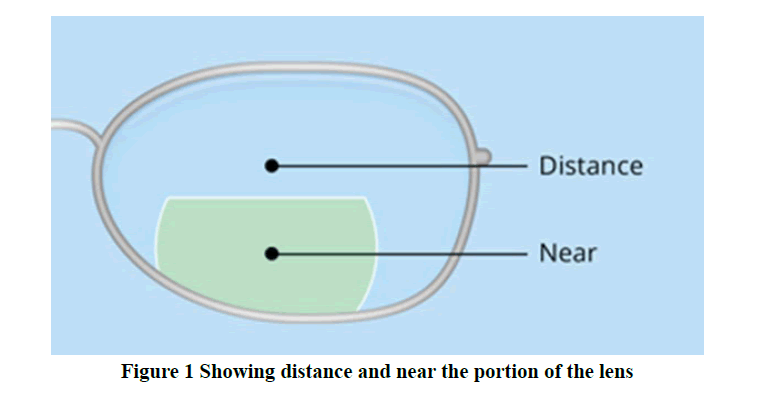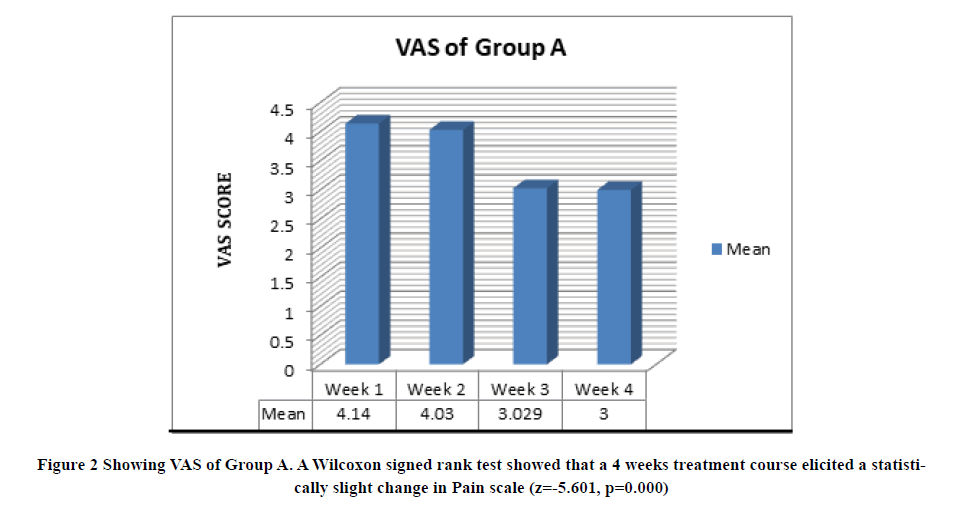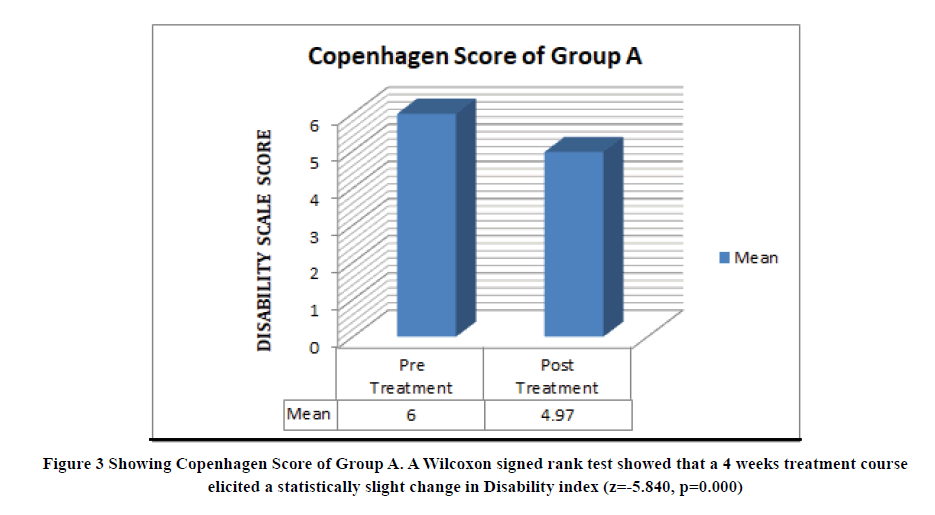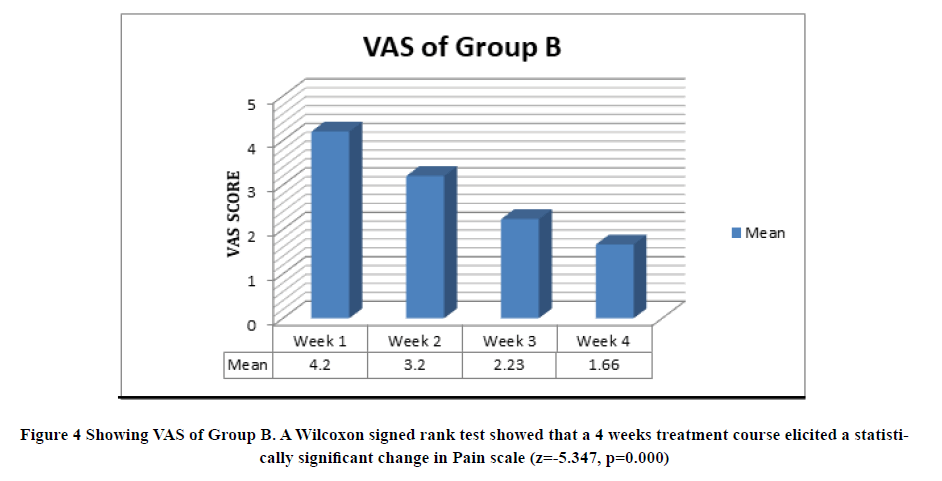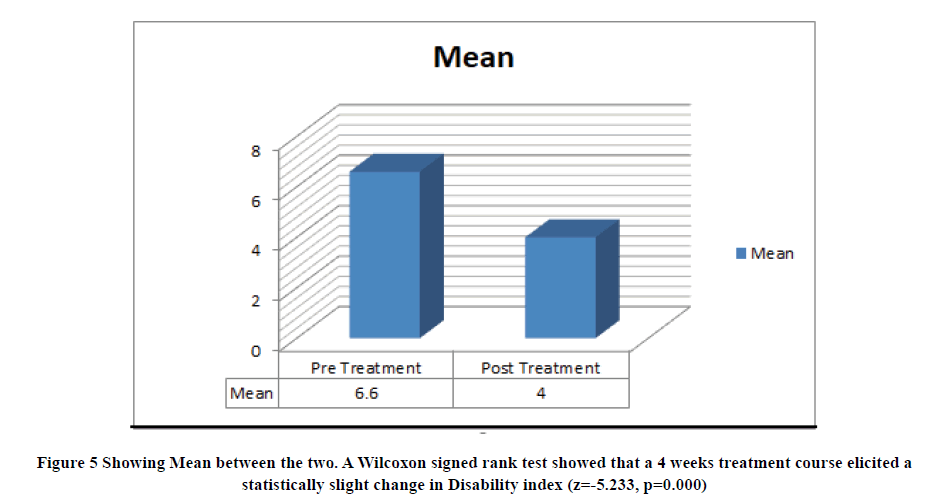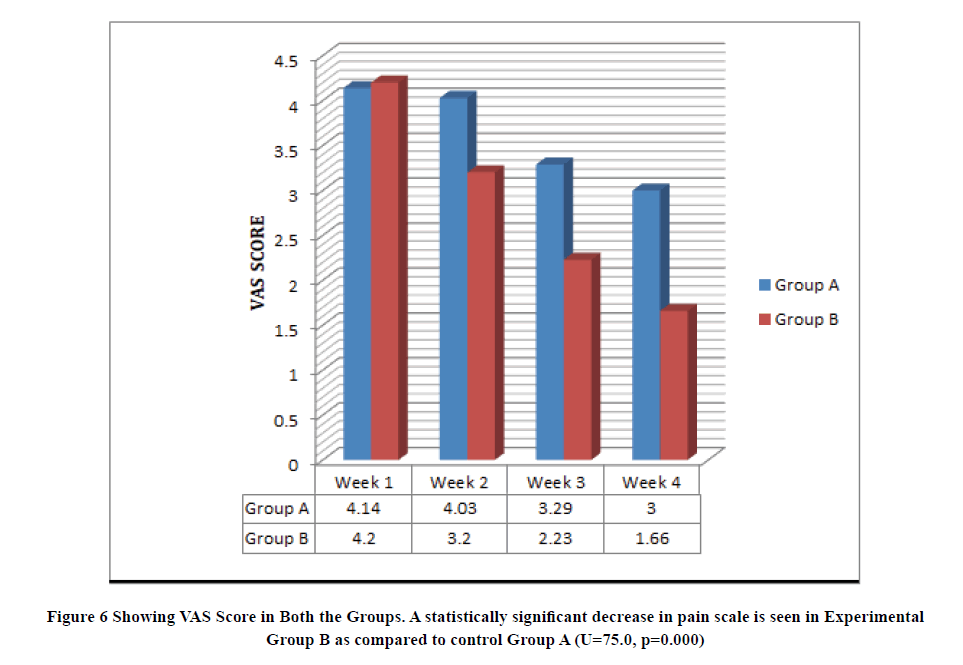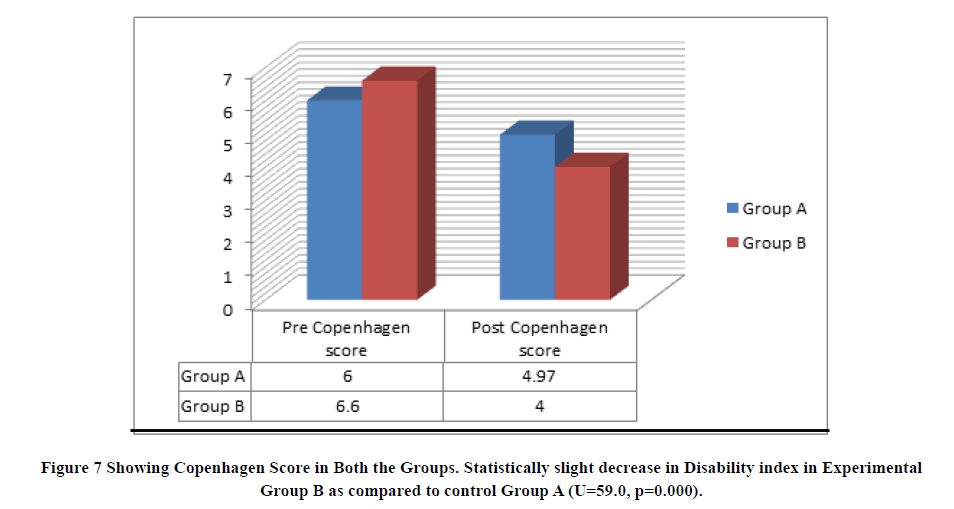Research - International Journal of Medical Research & Health Sciences ( 2021) Volume 10, Issue 1
Comparison of Effect of Eye Exercises Along with Neck Setting Exercises versus Neck Setting Exercises Alone on Neck Pain and Quality of Life in Middle-aged Computer Users with Bifocal Lens
Pratibha Gaikwad*Pratibha Gaikwad, Department of Physical Therapy, Lokmanya Tilak Municipal General Hospital and Medical College, Sion, Mumbai, India, Email: pratibha.gaikwad@yahoo.co.in
Received: 02-Dec-2020 Accepted Date: Jan 22, 2021 ; Published: 29-Jan-2021, DOI: O
Abstract
This study aimed at comparing the pre and post effect of eye exercises along with neck setting exercises (experimental group) and neck setting exercises alone (control group) on neck pain and quality of life in middle-aged computer users with bifocal lens. Furthermore, a comparison between these groups was done. A population of 70 was evaluated in first and fourth week using Visual Analogue Scale and Copenhagen Scale. It was concluded from the study that there is a significant decrease in neck pain and improvement seen in quality of life after four weeks of Eye exercises along with neck setting exercises.
Keywords
Eye exercises, Neck setting exercises, Computer users, Bifocal lens
Introduction
Computers and mobile computing devices are being used by increasingly larger number of people today. This has led to an increase in the number of patients complaining about ocular and non-ocular symptoms related to computer use especially in individuals using bifocal lens. Bifocal lens has a small portion in the lower part of the lens which contains the power required to correct your near vision. The rest of the lens usually is for your distance vision. Generally, when you look up and through the distance portion of the lens when focusing on points farther away, and you look down and through the bifocal segment of the lens when focusing on reading material or objects within 18 inches of your eyes (Figure 1).
Bifocal lens is used by individuals with presbyopia. Presbyopia leads to hardening of lens, loss of accommodation power, inability to focus on near objects. Eyestrain, tired eyes, irritation, burning sensations, redness of eyes, dry eyes, blurred, and double vision reported by the visual display unit users was termed “Computer Vision Syndrome” (CVS).
According to the American optometric association, Computer Vision Syndrome, also referred to as Digital Eye Strain, describes a group of eye and vision-related problems that result from prolonged computer, tablet, e-reader, and cell phone use [1]. Prevalence amongst computer users is (75-90)%.
Symptoms:
- Eye strain and fatigue
- Blurred vision
- Headache
- Neck and shoulder pain.
It is common in computer users with the bifocal lens. According to author Hans O. Richter, during poor near work conditions, the optical axis of the eyes may diverge relative to the target of regard [2]. Consequently, accommodation/convergence may no longer be optimally postured onto the target, resulting in blur and/or double vision in the retinal image. Under such adverse circumstances, a compensatory response may be elicited by the central nervous system, with the goal of realigning the oculomotor response onto the target. When triggered by strenuous near work, central nervous system efferentation targeted to the oculomotor system may cross over to motor tracts and drive and posture the visual-musculoskeletal effectors leading to overactivation of muscles. Trapezius is the most affected muscle. Since trapezius is a neck extensor muscle which causes extension of neck during reading in computer users with bifocal lens leading to neck pain over a period. An increase in visual load over time due to deficient optical aspects of near work causes eye symptoms and can lead to increase in musculoskeletal load and symptoms in neck area known as work-related neck pain. Prevalence amongst neck pain in computer vision syndrome is 15%-44% globally. According to article published by Sudaw Lertwisuttipaiboon et al, eye exercises can be used to treat eye pain in computer users [3]. Hence, this work-related neck pain in computer users with bifocal lens can be treated with eye exercise program along with neck setting exercises. According to Gary Heiting, eye exercise program includes [4]:
- Incorporation of visual breaks after 20 minutes.
- 20-20-20 rule: every 20 minutes, look 20 feet away for 20 seconds.
- Continuous blinking: every 20 minutes, blink 10 times.
Need of Study
- The importance of regular break intervals and neck setting exercises has been established as an aid to improve neck pain in computer users with the bifocal lens.
- There is higher risk in individuals with the bifocal lens as they have difficulty in adjusting and focusing on near objects.
- Neck setting exercises alone are not enough to treat neck pain in such cases as the relative posture increases the risk of recurrence.
- Thus, a need was felt to study the effects of eye exercises along with neck setting exercises to prevent recurrence and treat neck pain in computer users with the bifocal lens.
Aim
To compare the effect of eye exercises along with neck setting exercises versus neck setting exercises alone on neck pain and quality of life in middle-aged computer users with the bifocal lens.
- To determine the pre and post effects of four weeks of neck setting exercise alone on neck pain by using Visual Analogue scale and quality of life by Copenhagen Disability Scale (A-control group).
- To determine the pre and post effects of four weeks of eye exercises along with neck setting exercise on neck pain by using Visual Analogue scale and quality of life by Copenhagen Disability Scale (B-experimental group).
- To compare the pre and post effects between the two groups (A and B).
Hypothesis
Null Hypothesis
There will be no significant difference between four weeks of eye exercises along with neck setting exercise and neck setting exercise alone on neck pain and quality of life in middle-aged computer users with bifocal lens.
Alternate Hypothesis
There will be significant difference between four weeks of eye exercises along with neck setting exercise and neck setting exercise alone on neck pain and quality of life in middle-aged computer users with bifocal lens.
Study Description
Type: Experimental, Comparative
Type: Experimental, Comparative
Type: Experimental, Comparative
Sample size:
GROUP A control group: 35 Subjects
GROUP B Experimental group: 35 Subjects
Total: 70 Subjects
Sampling Method: Simple random sampling (by chit method).
Inclusion Criteria:
- Male and female in the age group of 35-55 years.
- Individuals with bifocal lens using computer for minimum four or more hours.
- Individuals having neck pain with the score of 3-5 on Visual Analogue Scale on activity.
Exclusion criteria:
- Individuals diagnosed with glaucoma, cataract, any previous eye operation.
- Any degenerative, inflammatory musculoskeletal condition like Rheumatoid arthritis, osteoarthritis, ankylosing spondylitis.
- Any recent injury like fracture, dislocation of neck.
Material and Methods
Methodology
- Subjects were selected on the basis of inclusion, exclusion criteria and by using simple random sampling technique (chit method).
- Subjects in the age group of 35-55 years were screened for presence of neck pain using Subject Evaluation Form.
- Neck pain was quantified using Visual Analogue Scale on activity in (0) week.
- The need of study, procedure was explained to the subjects in the language they understand.
- An informed written consent was taken from all the subjects participating in the study.
- Control group was given neck setting exercise alone for four weeks.
- Experimental group was given eye exercises along with neck
- Setting exercise for four weeks.
- The effects of eye exercises along with neck setting exercise were analyzed after four weeks using VAS scale on activity and Copenhagen Disability Scale.
Exercises According to the Groups
Control Group: Neck setting exercise alone (chin tucks; 10 reps, 1-2 times daily for 4 weeks)
- Static contraction of trapezius muscle
Experimental Group:
Eye exercises (daily for weeks) along with neck setting exercises (chin tucks; 10 reps, 1-2 times daily for 4 weeks). Patient is sitting in comfortable position; eye exercise program is performed which includes:
- Incorporation of visual breaks after 20 minutes
- 20-20-20 rule: every 20 minutes, look 20 feet away for 20 seconds.
- Continuous blinking: every 20 minutes, blink 10 times
Neck setting exercises which includes static contraction of trapezius muscle.
Results
This study was conducted on 70 females (Table 1-3).
Table 1 Tabular representation of the various parameters in Group A
| Mean | Median | SD | SE | Lower Bound | Upper Bound | |
|---|---|---|---|---|---|---|
| Age | 53.09 | 1.48 | 0.25 | 52.58 | 53.6 | |
| Working (Years) | 32.23 | 2 | 0.34 | 31.54 | 32.92 | |
| Hours Spent on Computers | 6 | 0.8 | 0.14 | 5.72 | 6.28 | |
| VAS-PRE | 4.14 | 4 | 0.75 | 0.13 | 3.94 | 4.46 |
| VAS-POST | 3 | 2 | 0.76 | 0.12 | 1.63 | 2.15 |
| Copenhagen Disability Scale-Pre | 6 | 7 | 1.74 | 0.27 | 6.06 | 7.14 |
| Copenhagen Disability Scale-Post | 4.97 | 4 | 1.7 | 0.25 | 3.5 | 4.5 |
Table 2 Tabular representation of the various parameters in Group B
| Mean | Median | SD | SE | Lower Bound | Upper Bound | |
|---|---|---|---|---|---|---|
| Age | 53.03 | 1.72 | 0.29 | 52.44 | 53.62 | |
| Working (Years) | 32.66 | 1.79 | 0.31 | 32.04 | 33.27 | |
| Hours Spent on Computers | 5.89 | 0.67 | 0.11 | 5.65 | 6.12 | |
| VAS-PRE | 4.2 | 4 | 0.75 | 0.13 | 3.88 | 4.41 |
| VAS-POST | 1.66 | 3 | 0.68 | 0.13 | 2.74 | 3.26 |
| Copenhagen Disability Scale-Pre | 6.6 | 6 | 1.58 | 0.29 | 5.4 | 6.6 |
| Copenhagen Disability Scale-Post | 4 | 5 | 1.46 | 0.29 | 4.39 | 5.56 |
Table 3 Mean of VAS and Copenhagen disability score of Group A
| Parameters | Mean | SD |
|---|---|---|
| VAS-Week 1 | 4.14 | 0.774 |
| VAS-Week 2 | 4.03 | 0.746 |
| VAS-Week 3 | 3.029 | 0.75 |
| VAS-Week 4 | 3 | 0.766 |
| Pre Copenhagen-score | 6 | 1.748 |
| Post Copenhagen score | 4.97 | 1.706 |
The first objective was to determine the pre and post effects of four weeks of neck setting exercise alone on neck pain by using Visual Analogue Scale and quality of life by Copenhagen Disability Scale. (A-control group).
To determine the pre and post effects of four weeks of eye exercises along with neck setting exercise on neck pain by using Visual Analogue scale and quality of life by Copenhagen Disability Scale (B-experimental group) (Table 4).
Table 4 Mean of VAS and Copenhagen disability score of Group B
| Parameters | Mean | SD |
|---|---|---|
| VAS-Week 1 | 4.2 | 0.759 |
| VAS-Week 2 | 3.2 | 0.759 |
| VAS-Week 3 | 2.23 | 0.731 |
| VAS-Week 4 | 1.66 | 0.683 |
| Pre Copenhagen-score | 6.6 | 1.58 |
| Post Copenhagen-score | 4 | 1.46 |
To compare the pre and post effects between the two groups (A and B) (Table 5 and 6).
Table 5 Comparison of pre effects between two groups
| Parameters (VAS) | Group A | Group B |
|---|---|---|
| Week 1 | 4.14 | 4.2 |
| Week 2 | 4.03 | 3.2 |
| Week 3 | 3.29 | 2.23 |
| Week 4 | 3 | 1.66 |
Table 6 Comparison of post effects between two groups
| Parameters | Pre Copenhagen-score | Post Copenhagen score |
|---|---|---|
| Group A | 6 | 4.97 |
| Group B | 6.6 | 4 |
Discussion
A study was conducted on 70 subjects in the age group of 35-55 years in MTNL, Mumbai. This study was done to find the pre and post effects of four weeks of eye exercises along with neck setting exercises versus neck setting exercises alone on neck pain by using Visual Analogue Scale and quality of life by Copenhagen Disability Scale. Subjects were selected based on inclusion criteria. Procedure was explained and a written consent was taken. Neck pain was quantified using Visual Analogue Scale on activity in week (0). A case record form was given for assessment of symptoms. Follow-up was done once a week. The effects were analyzed using VAS scale on activity and Copenhagen Disability Scale.
In our study, we found that there is slight decrease in intensity of pain from 4.14 to 3 (p=0.000) in control group i.e. Group A as neck setting exercises causes stretching of the scalene muscles (side of the neck) and sub occipital muscles (lower back of head and top of neck) in conjunction with strengthening of the weakened upper thoracic extensors and the deep cervical flexors (Figure 2). Hence, it brings back the muscle in optimal length causing relaxation and thus improving the efficacy of the neck flexor and trapezius muscle.
A similar study was done by Ilknur Naz on seventy-three patients with neck pain in which endurance training (neck setting exercise protocol) was given for 6 weeks [5]. Deep cervical flexor endurance test was performed and score of pain and disability index was taken which showed improvement in endurance levels and reduction in disability score. From this, we can conclude that neck setting exercises can be used to treat neck pain in computer users.
A study was conducted by Jari Ylinen on one hundred eighty women with chronic neck pain to evaluate the rate of change in neck strength following high- and low-intensity neck muscle training and their effects on pain and disability [6]. Strength tests, neck pain, and disability indices were the outcome measures taken and follow-up after 2 and 6 months was given. This study supports our hypothesis wherein neck and shoulder muscle training showed to be an effective therapy for chronic neck pain.
In Figure 3, a mean of Copenhagen Disability Score of control Group A was taken and we found that there is a statistically slight decrease in disability index from 6 to 4.97 (p=0.000) as there is improved blood circulation causing the increased supply of nutrition and oxygen to the neck muscles and washing off of lactic acid formed due to muscle fatigue, thus causing a decrease in intensity of pain. Neck setting exercises also align the neck muscles back to their optimum length causing it to work efficiently. From the pre and post-treatment results of the disability index in Group A, we found an increase in the patient’s ability to read.
The objective of the study by Rene´ Fejer was to investigate the relationship between Neck Pain (NP) intensity, NP duration, and disability [7]. Pain intensity was measured using 11-box numerical rating scales, pain duration was measured using the Standardized Nordic Questionnaire, and disability was measured by the Copenhagen Neck Functional Disability Scale. The correlation between pain and disability found in this study was moderate and increased with an increasing number of pain sites.
A study was done by Ashiyat Kehinde to investigate the effects of neck stabilization exercises on pain, disability, craniovertebral angle and psychological status in fourteen patients (6 male and 8 female participants) with nonspecific chronic neck pain [8]. Subjects performed stabilization exercise two times in a week for eight consecutive weeks and were assessed for pain severity, level of disability, anxiety, depression and cranio-vertebral angle using the Numerical Pain Rating Scale (NPRS), Neck Disability Index (NDI), Hospital Anxiety and Depression Scale (HADS). There was significant reduction in pain severity (p=0.001) and improvement in function disability level (p=0.001).
In Figure 4, we took a mean of Visual Analogue Scale Score of Experimental group B and found that there is statistically significant change in intensity of pain from 4.2 to 1.6 (p=0.000) as additional eye exercises were given in this group along with neck setting exercises. Eye exercises might have caused increase in blinking activity that provides moisture to the eye by irrigation using tears; the eyelid provides suction across the eye from the tear duct to the entire eyeball keeping it from drying out causing less eye irritation and straining. In eye exercises, we also told the subjects to perform the 20/20/20 rule which strengthens the ciliary muscles leading to increase in accommodative power while reading which causes less eye strain. The decrease in visual load might have triggered less central nervous system efferentiation to oculomotor system leading to less compensatory postural changes and less over-activation of the trapezius muscle.
A similar interventional study for a period of 3 months was done in Dec 2013 by Dr. Rachna Gupta et al, on 330 people working at Bhopal showed that there was 46.5% reduction in aesthenopic complaints [9].
According to an article “Computer vision syndrome: causes, symptoms, and management in the pharmacy” published by Janki Barai propose that to ease symptoms of fatigue, computer users should follow the 20:20:20 rule, whereby every 20 minutes, individuals should take a 20-second break and focus on an object 20 feet away [10].
As seen in Figure 5, there is a statistically significant change in disability index from 6.6 to 4 (p=0.000) in experimental Group B as we found that because of the additional effect of eye exercises, there is the decrease of eye irritation and straining that causes less visual load and thus prevents compensatory postural changes which leads to decrease of pain. From the pre and post-treatment results of the disability index, it is seen that there is the improvement in reading activity, concentration level and usual leisure time activities.
As seen in Figure 6, a comparison of mean of Visual Analogue Scale of Group A versus Group B suggests that there is significant decrease in intensity of pain in Group B as additional effect of eye exercises along with neck setting exercises might have caused increase in blinking activity and strengthening of ciliary muscles that leads to less work-related eye straining that in turn causes decrease in visual as well as musculoskeletal load. Neck setting exercises causes strengthening of deep flexor muscles which bring the head in proper alignment with respect to the body that leads to optimal activation of trapezius muscle.
In Figure 7, a comparison of mean of Copenhagen Disability Scale of Group A versus Group B which suggests that there is slight difference between disability index of Group A and Group B. But there is improvement in reading activity, concentration level and usual leisure time activities seen in Group B.
Conclusion
It can be concluded from the study that in middle-aged computer users with the bifocal lens, 4 weeks of isometric neck setting exercises along with eye exercises showed significantly better results than isometric neck setting exercises alone in improving intensity of pain on Visual Analogue Scale and improving the score of quality of life on Copenhagen Disability Scale.
Clinical Implication
Eye exercises along with neck setting exercises should be incorporated in computer users. Isometric neck setting exercises along with eye exercises are easy, inexpensive and less time-consuming exercises which can be used on daily basis in clinical practice to reduce the intensity of pain in middle-aged computer users with bifocal lens. It can also be used to improve the quality of life in middle-aged computer users with bifocal lens.
Limitations
- Small sample size.
- Follow up for longer duration.
- It is not performed under supervision.
Suggestions
- If a study is done for a longer period, there might be increase in accommodation and decrease in the power of lens.
- If a study is done on larger population and for longer duration, there might be significant change in Copenhagen Disability scale score.
Acknowledgment
First and foremost, I would like to express my profound and heartfelt gratitude to my head of department Dr. Rajeshree Naik for her invaluable guidance throughout my research work. I always felt motivated by her dedication to excellence. I am indebted to her for the immense amount of time she has devoted in discussion to sort out queries and loopholes encountered all along the course of the project. Indeed, it has been a rewarding experience to work with her, which I would always cherish.
My sincere thanks also go to all my colleagues for their kind co-operation and guidance.
I would like to take this opportunity to thank my parents, and brother for their constant encouragement and unconditional support throughout the entire tenure of my research work.
Place: Sion, Mumbai
References
- Bali, Jatinder, Naveen Neeraj, and Renu Thakur Bali. "Computer vision syndrome: A review." Journal of Clinical Ophthalmology and Research, Vol. 2, No. 1, 2014, pp. 61.
- Richter, Hans O. "Neck pain brought into focus." Work, Vol. 47, No. 3, 2014, pp. 413-8.
- Lertwisuttipaiboon, Sudaw, et al. "Effectiveness of a participatory eye care program in reducing eye strain among staff computer users in Thailand." Risk Management and Healthcare Policy, Vol. 10, 2017, pp. 71.
- Heiting, Gary. "Bifocals and trifocals: solutions for "Short Arms"." All About Vision. https://www.allaboutvision.com/lenses/multifocal.htm
- Naz, Ilknur, and Yucel Yildirim. "Investigation of the relationship between wearing glasses and deep cervical flexor endurance in patients with non-specific neck pain." Journal of Back and Musculoskeletal Rehabilitation, Vol. 23, No. 3, 2010, pp. 143-9.
- Ylinen, Jari J., et al. "Effects of neck muscle training in women with chronic neck pain: one-year follow-up study." The Journal of Strength and Conditioning Research, Vol. 20, No. 1, 2006, pp. 6-13.
- Fejer, René, and Jan Hartvigsen. "Neck pain and disability due to neck pain: what is the relation?." European Spine Journal, Vol. 17, No. 1, 2008, pp. 80-8.
- Akodu, A., F. Odunsi, and S. Giwa. "Effects of neck stabilization exercise on pain, disability, craniovertebral angle and psychological status in patient with non-specific chronic neck pain." Journal of Riphah College of Rehabilitation Sciences, Vol. 6, No. 1, 2018, pp. 10-5.
- Ranasinghe, P., et al. "Computer vision syndrome among computer office workers in a developing country: an evaluation of prevalence and risk factors." BMC Research Notes, Vol. 9, No. 1, 2016, pp. 150.
- Barai, Janki, and Hammond Chris. "Computer vision syndrome: causes, symptoms and management in the pharmacy." The Pharmaceutical Journal, Vol. 299, No. 7908, 2017, pp. 363-6.

